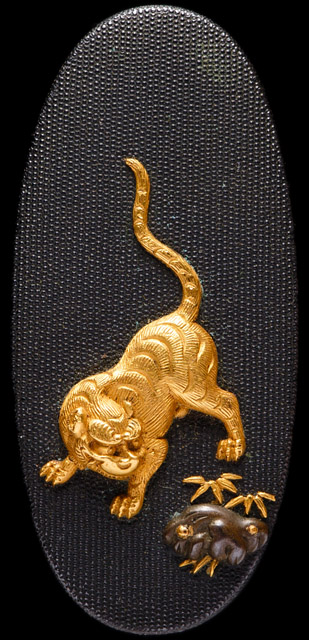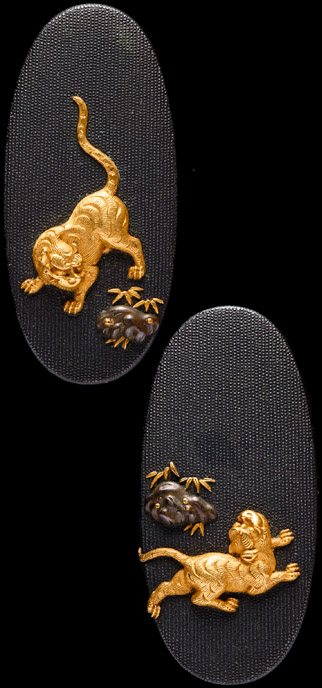Archived Nihonto.ca (Yuhindo.com): Araki Tomei
Araki Tomei
| period: | Late Edo (ca. 1850) |
| designation: | NBTHK Tokubetsu Hozon Tosogu |
| mei: | 吟枩亭東明 Ginshotei Tomei (kao) |
| form: | Daisho Fuchigashira featuring Tora (Tigers) in gold and shakudo |
| price: | N/A |
Please note, I submitted these unpapered for Tokubetsu Hozon in January, they’ve received the status and I am awaiting the papers to be delivered, hence there being no photo of them yet.
Goto Ichijo is likely one of the top three soft metal artisans of Japanese history, and certainly of the late Edo period. He shook the moribund style of the Goto main line out of its stasis and introduced new styles and materials which established his place in history as an innovator. Ichijo took commissions from the Emperor and was a house artist for the Tokugawa shogun. His artistic sense in my opinion is second to none, and his works never cease to amaze. Ichijo had many extremely skilled students who are considered among the grand masters of the time, indicating his own prowess as a teacher and his fame in his time as he attracted talented men to his circle.
Goto Ichijo began working in shibuichi, an alloy of silver and copper, after mastering the shakudo and gold house style of Goto. He reached the peak of his skill in this material, which carried forward into his use of iron which followed. Shibuichi makes a beautiful background material as in high grades it contains subtle texture, and provides good contrast for silver, gold and shakudo inlay, as well as good contrast for carvings.
Goto Ichijo taught several master students, and probably the most famous of them is Araki Tomei (荒木東明). Tomei was the son of a rice dealer named Yohei and born in Kyoto in 1817 with the personal name Honoshin.
Due to some interesting Japanese traditions, Honoshin having been born in the year of the Ox was unable to inherit the family rice business due to a custom of giving sons away born in this year to other families. His brother Yataro ended up inheriting the business, and Tomei went on at the age of 13 to apprentice under Goto Tojo Kosetsu (8th master of the Goto Kanbei line) as a kinko artist under and received the name Hidenobu to begin with.
As his apprenticeship progressed Goto Tojo gave him the first character of his own name, and he began signing work at this point as Tomei. Soon after he took up training with Goto Ichijo and received an additional name Issai, containing the first character of Ichijo’s name. This was a habit of Ichijo and permitted all of his main students the use of the Ichi character. Tomei would use this name on occasion in combination with Tomei in signing, unlike some of Ichijo’s other students who adopted their new name wholesale. Instead, he never abandoned the Tomei name. Mostly even after studying with Ichijo Tomei used the additional art name Ginshotei in front of Tomei, and also Shogintei, and together it’s thought that Tomei felt great appreciation for Goto Tojo and retained his gifted art name as a result.
During the period of his independence Tomei opened a shop at Yanagibajo dori in Kyoto. He also became friends with Hayashi Ranga (林 蘭雅) who was a famous painter, and he took up training in this art. He’s thought to have somehow during this episode come up with the knowledge for carving special millet heads which are found on the popular form of his work. To make these he designed and fabricated his own chisels, and the combination of chisel and technique has not been duplicated to this day. This design became very popular and remains popular due to their intricate beauty and today are very expensive though they are somewhat interchangeable.
Tomei worked mostly in sold gold and shakudo, but also worked on shibuichi and iron ground (which were innovations brought about by his teacher Ichijo).
Tomei died fairly young at 54 years old in 1870. The work he left to us today is highly sought after by collectors and has risen to Juyo and even Tokubetsu Juyo levels.
Tomei Daisho Fuchigashira
Though the millet heads of Tomei are unquestionably beautiful and sought after, we can sometimes find his rare work outside of this theme and these can be very interesting. The millet work as I wrote above, is beautiful but it is a bit repetitive and there is some lacking of singular elements which can separate one work from another.
This daisho fuchigashira is a fantastic example where he has stepped away from his signature style and created something individual. The tigers represent a father and his son or sons, as the tigers on the dai are bigger than those on the sho. It seems to be a bit of a puzzle where you can arrange the tigers to form a scene in which they will look at each other.
Condition-wise it seems never to have been mounted, but was simply put away and stored until the present day. As a result they are absolutely mint condition.
Personally I find animal scenes done by the Japanese kinko artists to be my favorite, as they often embrace a charm and spirit which are lacking in the more martial themes and in the more abstract themes. I found these in Japan, unpapered, and was immediately attracted to the rich gold tigers and how well they stood out from the shakudo ground. The sharp, unworn carving makes the tigers sparkle in the light. This shakudo ground features extremely fine nanako and makes the perfect contrast with the lively tigers. After I saw the name underneath I was a bit wary as unpapered big names like this are always something to show concern about authenticity. The quality though spoke for themselves and I bought them and submitted to Tokubetsu Hozon in January which is a difficult level to achieve for Tosogu. The ranking was awarded and I am in the process of waiting for the papers to arrive now, so they have yet to be photographed.
Tomei signed these with his typical name Ginshotei Tomei, placed his kao and the sparse file marks on the surfaces of the fuchi are a technique that comes from Goto Ichijo, so this work represents him at his full training after release from apprenticeship under Ichijo. Under one of the kashira is some interesting marks but I’m not sure what to make of them. You can see them in the photos.
I really love this set, it would be delightful to display at home on a shelf or desk where they can be appreciated daily. I think it is a unique opportunity to get very special work of Tomei that can be used to compliment a set of millet and show the range of his work, or just to own by themselves. They come in a custom box with calligraphy on the front that says: Tora: Tomei saku (Tigers: made by Tomei), though it is not clear to me who made the calligraphy and how far back it goes.


